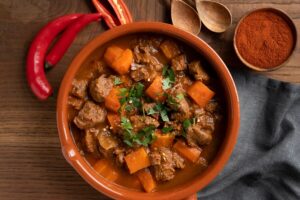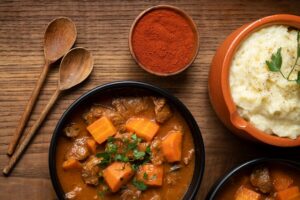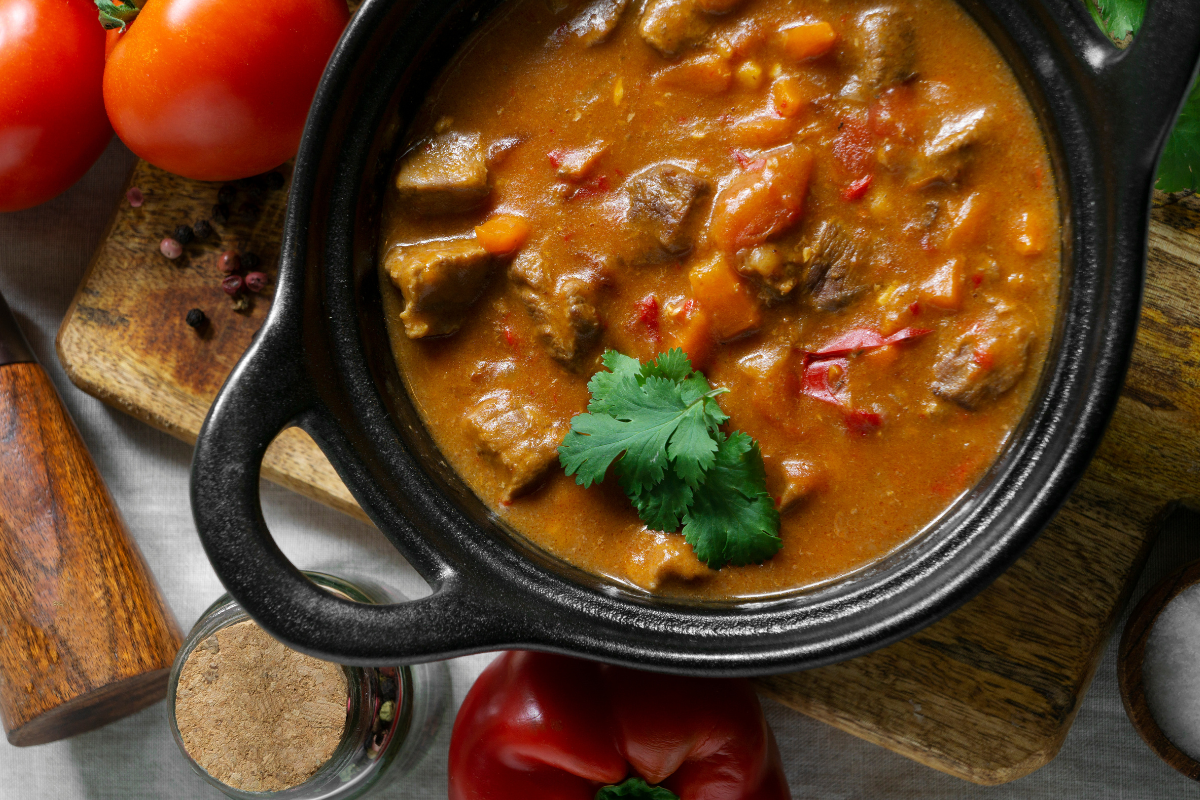Goulash offers more than just a simple stew , it embodies a rich tradition and history, especially within Hungarian culture. Its name, Gulyás, comes from the Hungarian word for herdsmen, reflecting its origins as a humble meal prepared by cattle herders. However, goulash has since transcended its roots to become a beloved dish across Europe and beyond, known for its rich flavor ,taste and hearty nature.
But what exactly does goulash taste like? The answer is not straightforward, as the taste of goulash can vary significantly depending on the region and the specific ingredients used. However, traditional Hungarian goulash is typically characterized by a savory and slightly spicy flavor, with a depth that comes from its carefully selected ingredients and slow-cooked preparation. This article delves into the specifics of what gives goulash its unique taste and how it can vary depending on the recipe and region.
Ingredients That Define Goulash taste
The taste of goulash is defined by its core ingredients, each contributing to the dish’s complex flavor profile. Let’s take a closer look at these ingredients and how they come together to create the distinctive taste of goulash.
Beef
Beef is the primary meat used in traditional goulash. It provides a rich, hearty flavor that forms the backbone of the dish. The type of beef used can vary, but it is typically a cut that benefits from long, slow cooking, such as chuck or shank. These cuts have enough fat and connective tissue to remain tender and juicy after hours of simmering.
Paprika
Paprika is arguably the most important ingredient in goulash. It is what gives the dish its characteristic red color and adds a sweet, slightly spicy flavor that is essential to the dish. Hungarian paprika is known for its high quality and comes in various grades, ranging from sweet and mild to hot and spicy. The type and amount of paprika used can significantly influence the overall flavor of the goulash.
Onions and Garlic
Onions and garlic form the aromatic base of goulash. They are typically sautéed at the beginning of the cooking process, allowing their flavors to meld with the meat and paprika. The sweetness of the onions balances the spiciness of the paprika, while the garlic adds a subtle depth to the flavor.
Tomatoes
Tomatoes were not part of the original goulash recipe but have become a common ingredient in modern versions of the dish. They add a slight acidity that helps to balance the richness of the beef and the sweetness of the paprika. Some recipes use fresh tomatoes, while others use tomato paste for a more concentrated flavor.
Potatoes
Potatoes are often added to goulash to thicken the stew and make it more filling. They absorb the flavors of the broth and become tender as the dish cooks. In some versions of goulash, such as Austrian goulash, potatoes are the main thickening agent, giving the dish a more stew-like consistency.
These ingredients, when combined, create a dish that is rich, hearty, and deeply flavorful. Each component plays a crucial role in building the layers of flavor that make goulash such a beloved dish.
For those looking to recreate this authentic taste at home, this Authentic Hungarian Goulash Recipe provides detailed instructions.
How Cooking Techniques Influence the Flavor

The cooking techniques used to prepare goulash are just as important as the ingredients in determining the final flavor of the dish. Traditional Hungarian goulash is all about patience—slow-cooking and simmering are key to achieving the deep, rich flavor that defines the dish.
Slow-Cooking
One of the hallmarks of goulash is its long cooking time. The beef is cooked slowly over low heat, allowing it to become tender and infuse the broth with its rich, meaty flavor. This slow-cooking process also allows the flavors of the other ingredients, particularly the paprika and onions, to meld together, creating a broth that is both savory and slightly sweet.
Simmering
After the initial sautéing of onions and garlic, the rest of the ingredients are added to the pot and simmered for several hours. Simmering helps to concentrate the flavors and thicken the broth, resulting in a dish that is deeply flavorful and satisfying. The low, steady heat ensures that the beef remains tender and the vegetables do not become mushy.
The combination of slow-cooking and simmering is what gives goulash its rich and hearty flavor. It’s a dish that requires time and patience, but the result is well worth the effort.
Regional Variations in Taste
As goulash spread across Europe, people adapted it to suit local tastes and ingredients, resulting in several regional variations. While all these versions are delicious in their own right, they each offer a slightly different take on the traditional flavor of goulash.
Hungarian Goulash
Hungarian goulash is the original and remains the most authentic version of the dish. It is characterized by its rich, paprika-forward flavor and a thick, stew-like consistency. The use of high-quality Hungarian paprika is essential, as it provides both the color and much of the flavor of the dish. This version of goulash is typically served with pinched noodles known as csipetke or crusty bread to soak up the flavorful broth.
Austrian Goulash
Austrian goulash, also known as Wiener Saftgulasch, is a close cousin to the Hungarian version but with a few key differences. It tends to be thicker, with more onions used to create a richer, more robust flavor. Austrian goulash is often spicier as well, with more paprika and sometimes additional spices like caraway or marjoram. It is typically served with boiled potatoes or dumplings, which help to balance the spice and soak up the thick sauce.
American Goulash
American goulash, also known as Slumgullion, is a completely different dish compared to its European counterparts. Rather than a stew, American goulash is more of a pasta casserole, made with ground beef, tomatoes, and macaroni. It is a quick and easy dish, popular for its simplicity and adaptability. However, it lacks the deep, rich flavors of traditional Hungarian goulash, focusing instead on the comforting combination of pasta and beef.
These regional variations demonstrate how cooks adapt goulash to suit different tastes and ingredients, creating a wide range of dishes that still retain the comforting nature of the original.
The Taste of Traditional Hungarian Goulash
Now, let’s get to the heart of the matter—what does traditional Hungarian goulash actually taste like?
Imagine a cold winter evening, and you’re sitting down to a steaming bowl of goulash. The first thing you notice is the rich, savory aroma wafting up from the bowl, a combination of slow-cooked beef, onions, and paprika. As you take your first bite, the flavors hit you all at once—the deep, beefy richness of the meat, the sweetness of the onions, and the slight spiciness of the paprika. The broth is thick and velvety, coating your palate with layers of flavor.
The paprika provides a warmth that lingers on your tongue, but it is not overwhelming. Instead, it complements the richness of the beef, adding a subtle heat that enhances the overall flavor of the dish. The onions and garlic add depth and sweetness, balancing the savory and spicy notes. The potatoes, having absorbed the flavors of the broth, are tender and comforting, adding a creamy texture to each bite.
Overall, the taste of traditional Hungarian goulash is one of comfort and satisfaction. It is a dish that warms you from the inside out, with a depth of flavor that comes from hours of slow cooking and carefully balanced ingredients. It’s a meal that is both hearty and soul-satisfying, perfect for a cold day or whenever you need a bit of comfort food.
Texture and Mouthfeel
The texture of goulash is just as important as its flavor. A well-made goulash should have a thick, stew-like consistency, with each component contributing to a satisfying mouthfeel.
Beef
The beef in goulash should be tender and juicy, almost melting in your mouth after hours of slow cooking. It should be easy to cut with a spoon, yet still have enough texture to provide a satisfying bite.
Vegetables
Cook the vegetables, especially the potatoes, until they are soft but not mushy.. They should retain their shape and add a contrasting texture to the tender beef and thick broth.
Broth
The broth of a good goulash should be thick and rich, coating each bite of beef and vegetables with a velvety texture. It should not be watery but rather have a consistency that is closer to a sauce than a soup.
This combination of textures makes goulash a deeply satisfying dish. The tender beef, soft vegetables, and thick broth all come together to create a meal that is both comforting and hearty.
Popular Sides and Accompaniments

Goulash is often served with a variety of sides that not only complement its flavors but also help to make the meal more filling. Here are some popular accompaniments:
Noodles
In Hungary, people traditionally serve goulash with small, pinched noodles known as csipetke. They make these noodles from flour, eggs, and water, similar to dumplings. Cooks add them to the goulash during the last few minutes of cooking, allowing the noodles to absorb the broth’s rich flavors. The result is a hearty and satisfying side that pairs perfectly with the thick stew.
Bread
A crusty loaf of bread is another popular accompaniment to goulash. The bread is perfect for sopping up the flavorful broth, ensuring that not a drop goes to waste. In Hungary, it is common to serve goulash with a type of bread known as kifli, which is similar to a crescent roll.
Pickles
You often serve pickles alongside goulash to provide a sharp contrast to the richness of the stew. Their acidity cuts through the hearty flavors of the beef and paprika, offering a refreshing balance to the meal. Hungarian pickles, known as savanyúság, typically use cucumbers, cabbage, or peppers and ferment them in a brine of vinegar, water, and spices.
Pairing goulash with these sides not only enhances the flavors but also makes the meal more complete and satisfying.
For example, pairing goulash with a Beef Chuck Roast can elevate the entire dining experience, bringing out the hearty flavors of both dishes.
Best Beverages to Pair with Goulash
When it comes to beverages, there are a few options that pair particularly well with goulash. Here are some recommendations:
Red Wine
A robust red wine, such as a Hungarian Kadarka or Bikavér, is an excellent choice to accompany goulash. The wine’s deep, fruity flavors complement the richness of the beef and the spiciness of the paprika, creating a harmonious balance of flavors. The tannins in the wine also help to cut through the fat in the beef, making each bite more enjoyable.
Beer
A cold, crisp beer is another popular pairing with goulash. A Hungarian lager or pilsner is a great choice, as its light, refreshing taste provides a contrast to the hearty flavors of the stew. For those who prefer a darker beer, a stout or porter can also work well, as its roasted malt flavors complement the richness of the beef and the depth of the broth.
Hungarian Spirits
For those who want to keep things traditional, a glass of pálinka is the way to go. Hungarians craft this traditional fruit brandy, pálinka, from various fruits like apricots, plums, or cherries. Its sweet, sharp flavor contrasts nicely with the savory flavors of goulash. Pálinka is typically served as a digestif, but you can also enjoy it alongside the meal.
These beverages not only complement the flavors of goulash but also enhance the overall dining experience.
FAQs
What does goulash taste like compared to other stews?
Goulash has a unique flavor profile dominated by paprika and slow-cooked beef, making it richer and slightly spicier than most other stews. The use of paprika gives it a distinctive warmth, while the slow cooking process results in a deep, hearty flavor that sets it apart from other stews like beef bourguignon or Irish stew.
Is goulash always spicy?
Traditional Hungarian goulash has a mild spiciness due to the paprika, but it’s not overwhelmingly hot. The spice level can vary depending on the type and amount of paprika used. Sweet paprika will result in a milder goulash, while hot paprika can add a bit more heat. However, even when you use hot paprika, the richness of the beef and the sweetness of the onions typically balance the spice.
What is the difference between Hungarian and American goulash?
Hungarian goulash is a slow-cooked stew with rich, savory flavors, while American goulash, or Slumgullion, is a quicker pasta dish with ground beef and tomato sauce, lacking the depth of the Hungarian version. American goulash is ideal for weeknight dinners, whereas Hungarian goulash requires more time and patience, showcasing its traditional, hearty nature.
Final Thoughts on the Taste of Goulash
In conclusion, goulash is a dish that embodies the essence of comfort food—rich, hearty, and satisfying. Its complex flavor profile, derived from carefully selected ingredients and traditional cooking methods, makes it a culinary experience worth savoring.
Enjoying a bowl on a cold night or exploring its variations, goulash delivers Hungary’s rich culinary heritage in every bite.
For those looking to explore similar hearty dishes, the Ground Beef Guide offers insights into how different cuts of meat can enhance your cooking.
Understanding the ingredients, cooking techniques, and regional variations will help you appreciate the nuances of goulash and inspire you to try making it.
These regional variations demonstrate how cooks adapt goulash to suit different tastes and ingredients, creating a wide range of dishes that still retain the comforting nature of the original. If you’re curious about other types of beef dishes, explore this comprehensive guide on sirloin tip steak.

